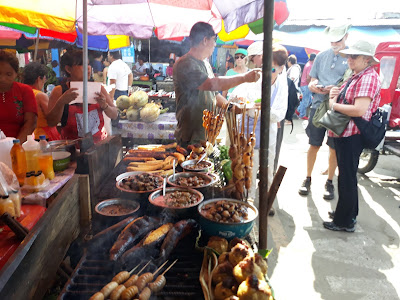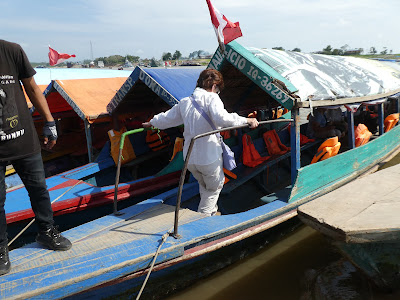Iquitos is Peru's main river port, established in 1864 in the heart of rubber country on the Amazon's deep waters. Access to the city is by air or river only. Iquitos is known as the "capital of the Peruvian Amazon."
We arrive in Iquitos and board a coach bus to head to our hotel.
Iquitos is a city of 600,000 people and about 700,000 motor taxis and motorcycles. In other parts of the world we know them as tuk-tuks, and they are everywhere.
It's a Saturday and people are out everywhere. Jose' says it's too hot to stay indoors. But we say it's really hot outside! Not all buildings have AC, but our hotel does! Whew!
Like we have seen in our travels before, electrical wires are strung like webs outside the buildings.
After lunch we take an orientation walk with our Trip Leader, Jose' and local guide Erik. We walk just a couple blocks from our hotel to this overlook. This is low-water season in the Amazon River basin.
During high-water season, this area is flooded and this building actually floats up with the rising water. We are standing about 30 feet above this building and the river will flood up to where we stand.
Now, just a few facts about the Amazon River basin. The entire basin is about the size of the contiguous 48 states. Here's a map to show you its size...The green represents the Amazon River basin. It is made up of many rivers and streams.
Here's how big it really is in relation to the USA
And the Amazon River, at 4,000 miles in length, is the longest river in the world.
By the time it reaches the Atlantic Ocean, the freshwater discharge from the Amazon River EVERY DAY could provide the freshwater needs of New York City for NINE YEARS! Amazing, eh?
We strolled along the boulevard.
There are important buildings from the rubber boom times that line the boulevard and the main plaza area.
The plaza is a site of nightly entertainment
The next morning we started our day with a walk through the local Nanay port market, where vendors were set up cooking and selling...well, food?
We wander around taking in all the sights and smells.
This is caiman, a relative to the crocodile.
And here is Terry tasting caiman. His expression tells all!
This is turtle soup...cooked in the shell...why dirty pots, right?
And then for dessert!
They say it tastes like chicken...we'll see! Here's Ken giving it a try.
Tastes like grease to me!
We then walked down to the water's edge and boarded a small ferry boat to head to a wildlife refuge center.
We cruised along the river for about 20 minutes, passing by the Peruvian Naval station.
And when we pulled up to the shore, we saw our next mode of transportation waiting for us.
The motor taxis.
We climbed aboard and off we went.
Arriving at the Pilpintuwasi Butterfly Farm and Animal Rescue Center.
We received a guided tour by the owner and founder of the refuge center, Gudrun Sperrer from Austria and volunteer Kian, from Germany.
We headed first into the butterfly area.
She is very passionate about protecting wildlife in Peru. That's a butterfly she is holding.
We also saw monkeys and birds that have been nursed back to health here....
a couple of sloths
And even Pedro the jaguar, an endangered animal.
Lastly, a tapir.
After the refuge center, we went to visit a "Maloca" (community center) that belongs to the Cucama-Cucamilla" indigenous tribe.
They very kindly welcomed us and performed a song...
and a dance...
And then invited us to dance with them.
In the afternoon we had free time to recover from the heat of the day. Some of us joined Jose' for a visit to the "Ethnic Museum" in Iquitos--it was air-conditioned!!
We learned some history of the tribes in the Amazon.
Saw some shrunken heads.
And Terry had a chance to use a blow gun.
Early the next morning we rode the local bus to the Belen market.
We made our way through the market area to the very end of the vendors.
We stopped here. Our local guide, Erik, explained that down this street is the very dangerous and the very black market for wildlife, Valencia, I think he called it. Not even police want to go down there.
We went here as part of a "controversial" topic so that we learn about not only the good, but the bad and ugly part of Peruvian society. At this point everyone was told to put their cameras away. Then a young man with a backpack came to us and we had a conversation, which was very educational and eye opening. He was a dealer in the black market for wildlife, any wildlife from the Amazon area. There are people who will pay great amounts of money for anacondas, turtles, monkeys, caimen, and even jaguars.
He opened his backpack and showed us a turtle that he was going to sell. Then he reached in and pulled out an anaconda snake about 4 feet long. The snake was not happy and fought and wriggled in the hands of the dealer and soiled him with bodily waste. At this point, everyone was taking a big step back. The captive wildlife do suffer in the hands of the black market people and many die enroute to the buyers. The black market people lack the proper training to care for the animals....a sharp contrast to the Pilpintuwasi refuge center we visited the day before. I do not think we will ever forget this controversial experience.
Leaving the black market dealer, we explored the big market of Belen.
Turtle eggs...
Locals sell all kinds of aphrodisiacs and "energizers" in the famous "Paquita alley" of the market.
That was quite the morning and we hadn't even checked out of our hotel yet. So, we took the motor taxi back to the hotel, checked out and rode a coach bus to Nauta town, where we embark on the LaPerla river ship to begin navigation on the Amazon River and tributaries.
To continue reading, scroll down and click on "Newer Post"







































































No comments:
Post a Comment